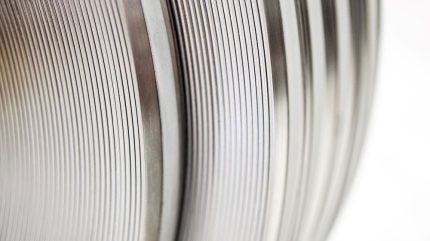
Disc springs are shallow conical washers that deform elastically under load, packing a high spring force into a small space. Their conical geometry and the way they are stacked allow engineers to precisely control load and deflection characteristics, making disc springs ideal for tasks such as absorbing vibration and compensating thermal expansion, all while fitting into tight mechanical assemblies. Unlike a coil spring, a Belleville washer flattens under load, distributing force evenly and remaining highly repeatable. Identical disc springs can be stacked facing the same way to multiply the total force, or in alternative directions to multiply deflection. Modular stacking enables designers to build a spring assembly with exactly the required stiffness and travel, saving space and customising performance in tools, valves, clamps and other devices.
Tight thickness tolerances on each disc mean that a stacked assembly behaves exactly as calculated, with little variation, so precision manufacturing is crucial for maintaining efficiency and reliability. Materials meeting these precision tolerances make for more predictable spring stacks, with industry standards such as DIN EN 16983/2093 and 16984/2092 defining how to calculate spring curves and fatigue life for disc springs for consistent production.
Choosing the right steel
The choice of steel for disc springs is a key factor. High-strength carbon-alloy steels are common, but purity and microstructure make all the difference in lifespan, so disc springs are usually made from specially rolled strip steel with very low inclusion content. Such steels are engineered to have very high purity and consistent microstructure, with low levels of inclusions that ensure reliability over time without cracks and failures. Some spring steel alloys, such as Alleima’s high-chromium grade 9RU10, are formulated for exceptional fatigue resistance and to resist relaxation under continuous load so that disc springs can cycle or hold loads for millions of cycles without creep or breakage.
In many applications, corrosion resistance is also important, so engineers may choose to coat a carbon-steel disc spring with a protective finish, such as a zinc-phosphate and oil coating. Other options include galvanising, zinc plating, or nickel plating for high-stress cases. However, Marta Invernizzi, materials engineering expert at Alleima, warns that coatings are not a cure-all, stating that phosphate or plated coating is “just a coating that can be removed over time by slip scratches”, especially under heavy use. In very aggressive environments or high temperatures, these surface treatments may fail. Instead, designers may turn to inherently corrosion-resistant spring steels. Austenitic stainless steels or specialised alloys can withstand harsher service, even at elevated temperatures. For example, Alleima’s high-performance chromium steel can resist corrosion and remain strong up to around 350C, far beyond what a plated carbon spring could handle.
Sustainability meets efficiency
Recycled steel avoids the consumption of additional oil for the extraction of raw materials and cuts CO2 emissions from mining and processing. Steel itself is already one of the most-recycled materials on the planet, and it can maintain its properties through endless cycles, meaning that spring steels can include a large fraction of recycled content without performance loss. Sustainability can be further improved if the production process itself uses clean energy. Alleima uses approximately 82% recycled steel and more than 96% fossil-free electricity in its furnaces during manufacturing.
However, it’s not all about recycling. High-quality disc springs contribute to sustainability by lasting longer and working more efficiently. Due to their consistent preload, they keep bolted joints tight without the need for re-torquing, saving labour, reducing downtime, and requiring fewer replacements. In balance-of-plant equipment such as valves or industrial clutches, reliable disc springs also mean less leakage and fewer breakdowns.
Looking forward, disc springs are finding roles in new energy applications such as hydrogen fuel cells and electrolysers. These devices stack many thin plates or membranes that must be clamped together, and if done insufficiently, it can lead to gas leaks or uneven reactions, while too much can damage the cell. Engineers are researching ways to use disc-spring stacks to provide an even, reliable compressive force on fuel-cell stacks, utilising their compact size and excellent high-temperature tolerance.
Small and often hidden within machinery, disc springs are proving to be a mighty contributor to sustainable engineering. In critical equipment from automotive clutch systems to renewable-energy stacks, disc springs help cut maintenance, enhance efficiency and even enable new technologies.
To find out more about how Alleima can work as your partner to design sustainable and efficient steel disk springs, download the whitepaper below.



